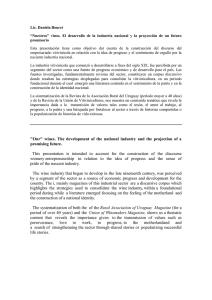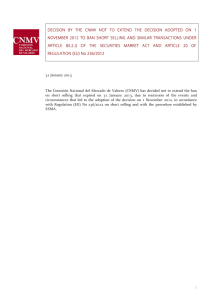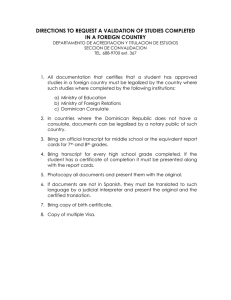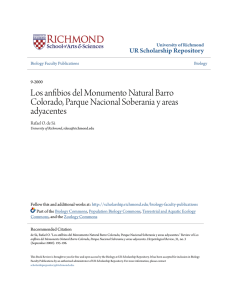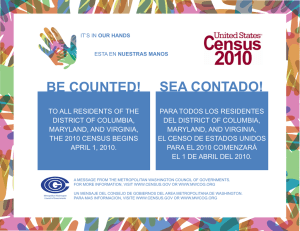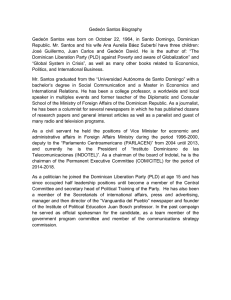Dominican Republic - Centro de Biodiversidad Marina
Anuncio
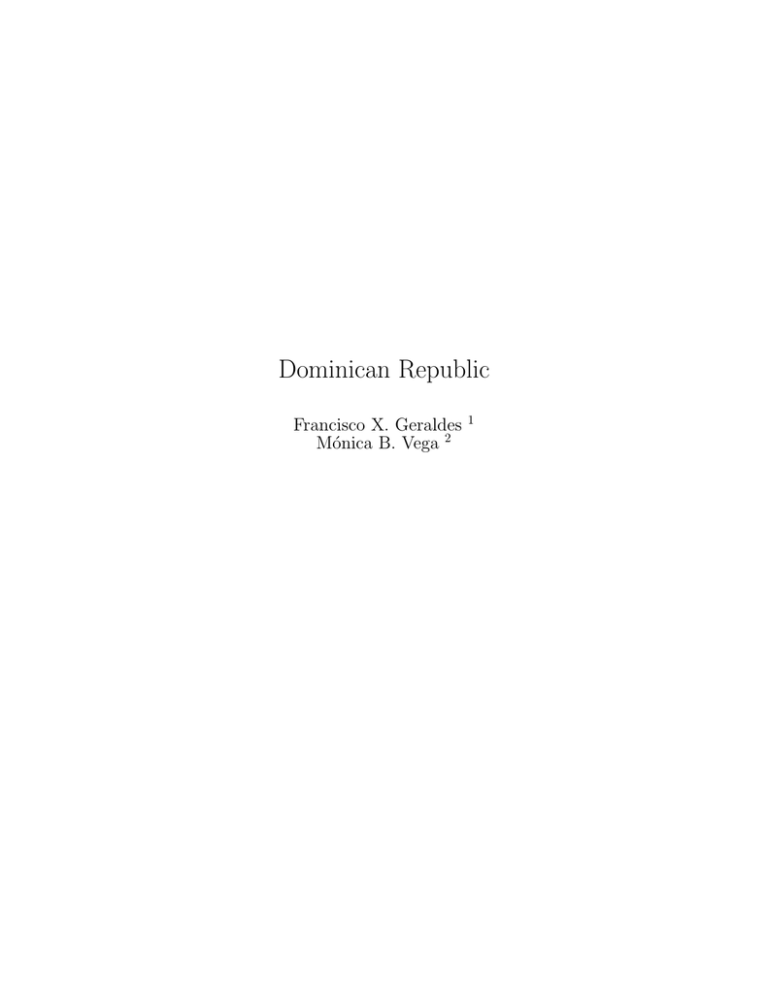
Dominican Republic Francisco X. Geraldes Mónica B. Vega 2 1 ABSTRACT The island of Hispaniola is the second largest in the Caribbean (78,000 Km2 ). It is politically divided into two countries: Haiti to the west and the Dominican Republic to the east. It has a land area of 48,484 Km2 , and a coastline of 1,389 Km, of these, 27% (376.7 Km) are mangroves, and 11% (166 Km) coral reefs and associated sea grasses. The rest of the coastline is mostly characterized by extensive sandy beaches and some coastal lagoons. Most of the coral reefs, mangrove forests and seagrass beds are located within established Marine Protected Areas (MPA’s), which cover about 22% of the coastline. The main coastal features found along the coasts are emerged reef terraces and cliffs, especially on the southeastern portion of the island. The continental shelf has a mean width of 7.5 Km and covers an area of 8,130 Km2 . There are two submerged offshore banks: La Navidad and La Plata, 70 and 150 Km2 respectively, located north of Cabo Samaná, in the Atlantic Ocean (North Coast). The first marine reports were done in the XVI and XVII centuries by Europeans. Studies by local scientists started in 1958. The marine biodiversity reports known for the country include a total of 1,392 species of the major taxa. The collections are located at the Centro de Investigaciones de Biologı́a Marina, Universidad Autónoma de Santo Domingo and Museo Nacional de Historia Natural. Threats identified along the coastal zone are due to the increase in urban, tourist and agricultural developments, associated with watershed intervention, river translocations and reservoir constructions for power and irrigation purposes. There is a need to update the marine biodiversity inventories and to maintain existing collections. 1 Centro de Investigaciones de Biologı́a Marina, Universidad Autónoma de Santo Domingo, Santo Domingo, Dominican Republic. mamma@verizon.net.do 2 Acuario Nacional, Avenida España, Sans Souci, Santo Domingo, Dominican Republic INTRODUCTION The island of Hispaniola is the second largest in the Caribbean (78,000 Km2 ). It is located at 17° 40’ and 19° 56’ N and 68° 20’ and 70° 40’ W, in the north central boundary of the Caribbean Sea. It is separated from Cuba to the northnorthwest by the Windward Passage (average 4,000 m depth), from Jamaica to the west-southwest by the Jamaica Passage, (average 3,000 m depth), and from Puerto Rico to the east by the shallow Mona Passage (average 350-400 m depth) (Figure 1). Figure 1. Dominican Republic coastal features and Marine Protected Areas for 2004 Hispaniola is politically divided into two countries: Haiti to the west and the Dominican Republic to the east (Figure 1). The Dominican Republic has a land area of 48,484 Km2 , and a coastline of 1,389 Km, of these, 27% (376.7 Km) are mangroves, and 11% (166 Km) coral reefs and associated sea grasses. The rest of the coastline is mostly characterized by extensive sandy beaches and some coastal lagoons. The main coastal features found along the coasts are emerged reef terraces and cliffs, especially on the southeastern portion of the island. The continental shelf has a mean width of 7.5 Km and covers an area of 8,130 Km2 . There are two submerged offshore banks: La Navidad and La Plata, with an area of 70 and 150 km2 respectively, located north of Cabo Samaná, in the Atlantic Ocean (North Coast). These banks are important winter breeding and mating territories for humpback whales. Many wrecks from colonial times (1500s) are found there. The circulatory pattern in the coastal waters is influenced by the Northern Equatorial Current, which flows westward towards the eastern shore, and then divides into northern and southern branches at the Mona Passage [1]. The northern branch of the current flows westward to Bahamas, Haiti, Cuba and Jamaica (Antilles Current). The southern branch enters the Caribbean Sea, and joins with the northernmost pulse of the Orinoco River at the Mona Passage and Saona Island. It creates rich environs suitable for shallow coastal ecosystems development, and pelagic nursery grounds, considered hotspots for conservation. The current continues to flow westward and joins the Caribbean Current. Coastal counter currents are associated with diurnal tides. The spring tidal range is 90 cm on the northern coast, and 20 cm on the southern coast. The climate of Hispaniola is mainly tropical dry, with an average annual temperature ranging from 18-27 °C. Cooler temperatures occur at the higher elevations (to -3 °C during winter months). There are considerable variations in the climate and the rainfall, which tends to decrease from east to west. Precipitation is greatest during the warm summer (May - November), and less during the cold winter (December - April). The mean annual rainfall is 1,395 mm. Predominant winds are the northeasterly trade winds during the winter and the east-southeast winds during the rest of the year [2]. MARINE AND COASTAL ECOSYSTEMS OF THE DOMINICAN REPUBLIC The Montecristi Barrier Reef, a Marine Protected Area (MPA), is located on the northern coast and near Haiti. It includes reefs and associated seagrass, mangrove and swamp ecosystems. At the western end of this barrier the coast changes due to the presence of the largest drainage of the island, the Yaque del Norte River, characterized by a mangrove-estuarine setting (39 Km2 ). To the north, in territorial waters some 167 Km from Puerto Plata, are the Silver and Navidad Banks (MPA), where during the winter months, the largest concentration of humpback whales, Megaptera novangleae can be found. They gather around the coral reef barrier at the northernmost section, facing the oncoming northeasterly winds from the Atlantic Ocean. On the northern coast and to the east of the Montecristi barrier reef, rocky shores and small bays surrounded by mangrove swamps are typical features up to Puerto Plata. From there and towards the east, sandy beaches, mostly of terrigenous origin, separated by mountains and cliffs are common. In some areas away from the near shore, coral formations appear. There is the large Bahı́a Escocesa, where recent fisheries studies have found deep-water squids and where sperm whales gather seasonally near Cabo Cabrón at the Samaná Peninsula. On the southern side of this peninsula are large watershed-basin drains, large mangrove forests (22 Km2 ), as well as an MPA. Following this easterly route along the coastline of the Dominican Republic, the sediments of the coast become terrigenous lime-sand. The Redonda and Limón coastal lagoons, both also MPAs, and the marshes are associated with them. Reaching Macao a large, 35 Km in length reef formation appears: the Bávaro - Macao reef. In this area, the largest tourism development in the island is found. The ecosystems are in constant stress and perpetually degrading due to the pressure they receive from the 1.3 - 2 million annual visitors. The features of this reef formation are similar to those found at the Silver Banks and other sites along the north coast. Around the eastern tip of the island is Cabo Engaño and the Punta Cana Juanillo reef, which faces the southeast (Caribbean Sea). The Bávaro - Macao reef and the Punta Cana - Juanillo reefs are located near the Mona Passage and borders two oceans, the Atlantic Ocean and the Caribbean Sea. This creates unique conditions since two different biogeographic provinces are found in one locality. On its southernmost area the reef becomes more distinct from its northern portion, which faces the Atlantic Ocean. The MPA Parque Nacional del Este is located on the southern coast, starting at Boca de Yuna and including the Catuano Passage and Saona Island. This park is characterized by fringing and patch reefs associated with large areas of seagrasses and fringing mangroves. Features associated with the typical marine habitat setting turns this area into an ideal breeding ground for many species, especially conchs of the genus Strombus, Panulirus lobsters, other invertebrates, and a myriad of fish species including groupers (Serranidae), snappers (Lutjanidae), grunts (Pomadasyidae), swordfish (Xiphiidae), marlin (Istiophoridae), and other pelagic fishes. Following the coastline towards the west, Pleistocene-Recent reef terraces and rocky shores dominate the landscape, interrupted by river discharges where most of the urban and industrial development of the island occurs. This includes Santo Domingo, the capital. Continuing west, the climate is dry and the coast changes into terrigenous sand-rubble and a narrow continental shelf. This includes four important coastal features: Bahı́a de las Calderas, Bahı́a de Ocoa, Puerto Viejo and Bahı́a de Neyba. All of them are fauna shelters in the northern Caribbean. The coastal and marine ecosystems and their extension along the 1,575 Km Dominican Republic coastline, are summarized in Table I. Ecosystems in these regions are characterized by a high tropical biodiversity. The most important marine biodiversity refuges are located in the MPA´s: Parque Nacional Montecristi (north), Parque Nacional del Este (east), Parque Nacional Submarino La Caleta (center), and Parque Nacional Jaragua (west). The types of coastal ecosystems found in these protected areas are mangroves, seagrass beds and coral reefs, which may cover large areas at Montecristi and Parque del Este (mangroves and seagrasses) and Jaragua (coral reefs). A summarized description of these parks is provided in the next section. Table I. Geomorphological characteristics of the coastline of the Dominican Republic. Region North Coast Lowlands and swamps Sandy beaches Cliffs and rocky shores East Coast Lowlands and swamps Sandy beaches Cliffs and rocky shores South Coast Lowlands and swamps Sandy beaches Cliffs and rocky shores Length (Km) 526 96 284 146 374 13 57 304 675 14 472 189 % of total 33.0 24.0 43.0 Marine Protected Areas (MPA’s) PARQUE NACIONAL MONTECRISTI At the northern coast of the Dominican Republic, Parque Nacional Montecristi has the largest reef formation in the country, with a length of 64.2 Km on the nearshore of the Montecristi Shoals (1,181 km2 ). The reef system is a barrier reef in accretion. High relief features and large living coral colonies with sizes exceeding 10 m in diameter are common. The deep reef has different characteristics, depending on location and position relative to currents, waves, wind direction, and tidal channels. The lagoon varies from 20 m to 2 Km wide and in some places is up to 20 m deep. Here, large areas of seagrasses and coral patches can be found, as well as skeletal remains of Acroporids. Although today a few young Acropora palmata are found, Millepora spp. are the dominant species. This change in dominance patterns could be attributed to the acroporid disease, and Millepora has replaced the previously dominant Acropora palmata and Porites spp. In most of the reef area, the crest is narrow and crossed by tidal channels. Here, waves from oceanic swells hardly reach this area, possibly due to the effect of the barrier shoal that reduces their force. The energy here is represented mainly by wind-generated waves with short periods (choppy seas), producing a low energy environment. On its oceanic side the crest abruptly drops vertically to 6 - 10 m in less than 30 m of horizontal distance. This allows a clear view of its basal structure, which is composed of large skeletons of A. palmata, A. cervicornis, Porites spp, and Montastraea spp. Some skeletons have broken loose and lie at the base of the crest. They are suitable substrates for future colonization and for refuge for other reef inhabitants. In exposed areas, there is evidence of a lower Acropora palmata zone consisting mostly of dead large colonies. Seaward, low relief spur and groove formations are found, with large colonies of the dominant Montastraea complex. There are variations to this zonation pattern. A portion of the break zone that faces away from the predominant forces of the wind and the waves is usually found when tidal channels divide the reef crest. This creates a very calm and protected portion on the reef. Here, the reef crest usually drops abruptly, sometimes down to 30 m, to a sandy channel with seagrasses. As this portion receives some ocean energy, the coral growth can form patches 10 to 5,000 m2 in area. PARQUE NACIONAL DEL ESTE (PNE) This park is the most studied marine site in the Dominican Republic [3–7]. Six categories of hard bottom substrate have been identified: (1) low relief spur and groove formations, (2) reef flats, (3) transitional reef communities, (4) patch reefs, (5) low relief rocky shoals, and (6) rocky coasts. The basal substrate for these formations is consolidated carbonate reef as well as sediments and rubble. The reefs of Parque Nacional del Este are basically low relief systems, found either as fringing, small deep (20-30 m deep) patches, or banks. Most are on the leeward side, protected by a land mass of Pleistocene and Recent reef terraces. Southeasterly trade winds are dominant. The reef on the leeward side has two distinct areas, one along the southern coast of Saona Island and influenced by oceanic currents, and the more protected one along the western side of the Catuano Passage. The bottoms of the Saona reefs are consolidated hard bottoms and octocorals. Sponges dominate the benthic communities. Hard corals are abundant only at specific places where they are concentrated, forming small and dispersed coral patches. Here the waves and currents are strong and in part are responsible for sculpturing these reefs. The reefs west of Catuano are basically sandy bottoms with patch reefs. Large amounts of sediments and biogenic sands are transported from the Catuano Passage and deposited along this coastline towards the west. Large seagrass meadows cover most of the very nearshore areas. Corals grow mostly in patches at a depth of 12 to 30 m. Further west, away from the influences of the Catuano Passage, coral patches increase in frequency and grow as deep-water fringing reefs. These are the most common reef structures of the southern coast of the Dominican Republic. PARQUE NACIONAL SUBMARINO LA CALETA This park is located in the center of the southern coast and to the leeward side of the Caucedo Peninsula. The area is surrounded by rocky shores. Nearshore there are sandy bottoms with patchy corals, as well as patchy seagrasses. Spurs and grooves appear at a depth of 10 m. At a depth of about 18 m, there is an abrupt drop to 25 - 40 m, where there are low and medium relief spur and groove formations. Here, there are reef-flat carbonate platforms, reef walls, and artificial reefs designed for fish aggregation. The main benthic organisms in this area are 32 species of corals, 20 species of octocorals, 50 species of sponges, and 45 species of algae. Due to the prevailing high-energy conditions of the sea, the benthic coverage by taxonomic group is 41% of algae, 13% of sponges, 13% of octocorals, and 28% of corals [8, 9]. This type of reef structure is commonly found along the south coast, which faces the Caribbean Sea, in places where the marine platform widens and depth is less than 40 m. In places where shallows and sandy beaches appear, fringing reefs with breakers are found (e.g. Boca Chica, Juan Dolio, Guayacanes and Najayo). From Rio Nizao to the west, terrigenous deposits from large rivers prevent reef formations all the way to Puerto Viejo (Bahia de Ocoa), where reefs develop again. PARQUE NACIONAL JARAGUA This park is located at the southwestern end of the Dominican Republic. No rivers or surface runoff are found on these Pleistocene carbonate reef terraces. On its windward side strong seas and high-energy pebble and pocket beaches with fringing reefs are found. On its leeward coast, protected by high cliffs, sheltered, long and white sandy beaches are common inshore and consolidated hard carbonate offshore with high coral cover and density. There is not a welldeveloped fringing or bank reef in most of the zone, except near Cabo Rojo [10]. At the southern tip, Beata Island is found. Further out is Alto Velo Island. Towards the southwest, at the edge of the continental shelf, is an elevation of the seafloor called Los Frailes Shoals [11, 12]. On the windward side of Beata island, at its northeastern end, coral reefs are located offshore forming bank reefs [10]. On the leeward side are seagrass beds, followed by a hard carbonate bottom with sparse corals, sponges, and octocorals, and a high cover of algae. An interesting formation is the Los Frailes Shoals, located 12 miles southwest of Cabo Rojo. This formation consists of a seafloor rise that receives clean oceanic waters. This allows establishment of a diverse community. There are boulders and submerged walls 10 m high covered by Tubastrea aurea on one side and large Montastraea, Diploria and Colpophyllia colonies, as well as sponges, on the other [10]. Starting at the Beata Canal, there is a platform that reaches up to 18 m depth, that goes from Cabo Falso to Bahı́a de Las Aguilas. It is covered with algae, hydrozoans, gorgonians, sponges, and has sparse coral colonies along its bottom. In deeper areas, there are diverse communities associated with large boulders. These are dominated by octocorals, zoanthids and sponges. In this area, sponge diversity and abundance are also significant, but corals are sparse. At Bahı́a de Las Aguilas, the reef has a higher coral diversity and coverage, and rare species such as Mycethophyllia reesi are uncharacteristically abundant [10]. Another different reef structure found at Jaragua is the reef at Cabo Rojo. Here the continental shelf forms a submarine canyon. The reef begins at 18 m depth on a wide platform covered by seagrasses. The reef then drops to 45 m to a sandy bottom. There is a high cover of plate-like species, which can be found in association with blue-green algae between 13 and 18 m. Octocorals are scarce and scattered along the slopes. Sponges are abundant and diverse. Millepora species and Acropora cervicornis patches are common in the shallow areas. Montastraea franksi and Agaricia lamarcki are the dominant coral species in the deep area of the reef [10]. MARINE RESEARCH IN THE DOMINICAN REPUBLIC Since 1958, several authors have published information regarding the marine environment of the Dominican Republic and its related biological diversity. Most of these studies, as well as the reference collections, have been deposited in the Museo de Referencia Costero Marina of the Centro de Investigaciones de Biologı́a Marina of the Universidad Autónoma de Santo Domingo (CIBIMAUASD), and in the Museo Nacional de Historia Natural. Several NGO´s have also carried out marine research and accumulated instructional and scientific materials. CIBIMA published a preliminary study of the coastal and marine biodiversity of the Dominican Republic and reported 224 species [13]. In 2003, Geraldes and a group of local scientists at CIBIMA updated the previous report to 1,391 marine and coastal species for the Dominican Republic (Table II) [14]. Table II. Summary results of preliminary revision of marine and coastal biodiversity for the Dominican Republic. July 2004. Taxonomic group Algae Seagrass Porifera Celenterata-hidrozoa Celenterata-madreporaria Gorgonidae Hidroideae Anelidae Chitonidae Molusca gasteropoda Molusca bivalvia Cephalopoda Crustacea Decapoda Crustacea Anomura Equinodermata Tunicata Pices Reptilia Mamifera Mangroves/ Flora Total Species 262 4 39 3 64 25 19 (no reports) 10 188 103 2 144 25 67 8 403 4 16 6 1392 Dominican contributors to coastal marine research include: C. GonzálezNuñez from 1954 until 1974 [15]; I. Bonnelly de Calventi from 1962 until 1999 [16], and more recently F.X. Geraldes from 1973 until present [7–9, 14, 17–28]. Research efforts in fishery studies have been carried out by E. Pugibet and N. Terrero [2–6, 9, 14, 22, 24, 27]. Researchers in other specific groups are G. Rosado (algae), H. Ramı́rez (plankton), C. Rodrı́guez (freshwater fishes), C. Dı́az and J. Gómez (mollusks), M. Garcı́a and C. Mateo (crustaceans), and L. Rathe (sponges) [29]. Most of these investigations were published at CIBIMA or at the Museo Nacional de Historia Natural. Researchers since 1995 include M. Vega, F. Geraldes and Y. Leon. They have produced several publications on marine environments and biodiversity [2–6, 8, 9, 23, 24, 26, 27], R. Torres [2–6, 9, 14, 22, 24, 27]. Since the inauguration of the Acuario Nacional in 1990, and through its efforts, much research and new studies have been produced. Table II summarizes the major biodiversity reports for the Dominican Republic. INITITATIVES FOR PRESERVING MARINE LIFE: LAWS AND REGULATIONS, MPA´S AND OTHERS In the year 2000 a new Environmental Law (64-00) was passed. This law created the institutional and legal framework for sustainable development and conservation of nature in the country. In charge of implementing this law is the Secretarı́a de Estado de Medio Ambiente y Recursos Naturales (Secretary of State of Environment and Natural Resources), with 4 executive branches (Subsecretarı́as). These are: Areas Protegidas y Biodiversidad (Protected Areas and Biodiversity), Recursos Costeros Marinos (Coastal Marine Resources), Recursos Forestales (Forest Resources) and Gestión Ambiental (Environmental Administration). They deal with the administration of the environment and of natural resources. The Dominican Republic has signed and ratified international treaties, such as MARPOL, CITES, the Convention of Biological Diversity, Climate Change, the SPAW Protocol, the Cartagena Convention, and the Basilea Convention, and has enhanced compliance with local environmental, fishery and development regulations. Concepts of integrated coastal management are just beginning to be applied. The Global Environmental Fund (GEF) of the World Bank has funded projects to assist in evaluating coastal resources and in designing national environmental policies. Shoreline development is controlled by law and restricts all constructions on the beach dunes or 60 m away from the high tide mark. Turbidity barriers, or some other method of sediment control, are required and are being used at coastal construction sites. The total coastal area protected as MPAs in the Dominican Republic is 30,015 Km2 . 4,775 Km2 occurs nearer to the mainland while the rest is the Silver Banks Marine Mammals Sanctuary (25,240 Km2 ). This sanctuary encompasses the territorial waters from Samaná Bay, including the Silver and Navidad Banks, and portions of the Mouchoirs Banks. The marine parks in the north are Parque Nacional Montecristi (1,309 Km2 ), Cabo Cabrón, in the Samaná Peninsula (552 Km2 ), and Los Haitı́ses in Samaná Bay with an important mangrove formation associated with the Yuna River (285 Km2 ); on the east Parque Nacional del Este (430 Km2 ). Those in the south are Parque Nacional Submarino La Caleta (10 km2 ), Boca Chica reef (5 km2 ), and Parque Nacional Jaragua (1,374 km2 ) near Haitı́. Other coastal ecosystems in the northwestern portion are swamps, marshes, and the Redonda and Limón lagoons. They are also part of the MPAs of the Dominican Republic. Nonwithstanding this ample legal frame and areas set aside for conservation, there is a lack of short and middle term policies and plans for biodiversity conservation and research. There is also a need for trained personnel at medium (technicians) and low (such as inspectors) levels in governmental offices with administrative duties for the marine and coastal zone. In the private sector, environmental education, sustainable management practices, promotion and propaganda are needed for the promotion of a change in attitude in regard to marine and coastal conservation and sustainable uses. THREATS TO MARINE BIODIVERSITY Degradation is taking place in most marine and coastal areas (except those included in the protected areas). Deforestation, irrigation projects, and overfishing, among others, have produced increased siltation and nutrient availability in the marine and coastal systems. There has also been a noticeable increase in human use of the coastal resources generated by population expansion, with subsequent increases of waste disposal (solid and untreated sewers) in coastal waters. Table III summarizes the percentage of ecosystems exploited by different socioeconomic activities (anthropogenic) and level of impact from those actions. These activities have destroyed or modified natural settings and have impacted areas by reducing or changing the biodiversity. The use of the coastal zones has been escalating and is associated with the expansion of the human population. The Dominican Republic has 9 million inhabitants and some 3.5 millions tourists visit the island each year. The territory has 48,484 Km2 , and a density of 1,090 persons per Km2 . Of these, 65% reside or have activities near the 1,389 Km coastline. Thus the actual calculated density of this territory is of 198 persons per Km of coastline. However, this number is much higher in the urban and tourist centers near the littoral zones. Table III. Areas of main marine ecosystems in the Dominican Republic and percentage of the marine and coastal areas used by human activities [25]. Ecosystems Mangroves Sea grass bed Coral reefs Beaches Other coastal ecosystems Country Area (Km2 ) Fisheries Tourism Urban / Industries Rural agro development 98.4 186.0 133.0 244.2 75 70 90 70 5 20 30 35 10 5 10 10 10 20 20 30 50,000.0 80 10 8 20 THE UNKNOWN: TAXONOMY, UNEXPLORED REGIONS, AND OTHERS The need for more research and explorations regarding the marine and coastal ecosystems of the Dominican Republic is obvious. From 1954 until 2004, local scientists have studied specific areas mainly in the southern and eastern coasts, dedicating efforts on ecological processes and fisheries. In this latter field, major efforts have been achieved in fisheries explorations [30]. Very few attempts have been accomplished in actual biodiversity collections targeted to specific habitats or ecosystems. Regarding ecological assessments, the field efforts have been more directed towards identifying, characterizing and determining the status of the ecosystems. Other works have been dedicated to determine environmental conditions. Since research has concentrated primarily in the MPAs, there are regions along the coastline (maybe even 60% of it, or 950 Km) that remain relatively unstudied. Little effort has been dedicated to biodiversity inventories in habitats other than coral reefs, and in taxa besides those of corals, octocorals, fishes, sponges, and other conspicuous benthic forms. Trained personnel with a high degree of knowledge in crustaceans, mollusks, echinoderms, and other less known groups such as plankton, worms, mud dwellers (swamps and marshes) and small sized creatures are needed to complete the local understanding and diversity richness of the marine and coastal ecosystems of the Dominican Republic. Finally, the level of the museums is poor to bad. There is no political or financial support for them, and collections have been lost by lack of maintenance. Some of the data (records) in them have partially been lost. REFERENCES 1. Metcalf, W. G., M. C. Stalcup, and D. K. Atwood, 1977. “Mona passage drift bottle study.” Bull. Mar. Sci., 27(3):586–591. 2. Chiappone, M., 2001. “Water Quality Conservation in Marine Protected Areas. A Case Study of Parque Nacional del Este, Dominican Republic.” Technical report, The Nature Conservancy. 3. Vega, M., 1994. “Evaluación ecológica rápida del área marina del Parque Nacional del Este, República Dominicana.” Informe final, Acuario Nacional. 4. Vega, M., G. A. Delgado, and K. M. Sullivan, 1994. “Rapid Ecological Assessment. Parque Nacional del Este, Dominican Republic.” Technical report. 5. Vega, M., M. Chiappone, G. Delgado, R. Wright, and K. Sullivan, 1997. “Evaluacion Ecologica Integral del Parque Nacional del Este, República Dominicana 2: Recursos Marinos.” Technical report, The Nature Conservancy, Bahamas. 6. Chiappone, M., 2001. “Coral Reef Conservation in Marine Protected Areas. A Case Study of Parque Nacional del Este, Dominican Republic.” Technical report, The Nature Conservancy. 7. Geraldes, F. X., 2003. The Coral Reefs of Dominican Republic. Elsevier Publisher. 8. Geraldes, F. X., 1994. “Inventario y elaboración del plan de manejo del Parque Nacional Submarino La Caleta. Primer informe parcial.” Documento de proyecto. pronatura/fman/pnud, Fundación Dominicana Pro-Investigación y Conservación de los Recursos Marinos, Inc. (MAMMA). 9. Geraldes, F. X. and M. Vega, 1995. “Evaluación Ecológica, Pesquera y Socioeconómica. Plan de Manejo del Parque Nacional Submarino La Caleta.” Informe final proyecto fman/pnud/pronatura, Fundación Dominicana Pro-Investigación y Conservación de los Recursos Marinos (MAMMA). 10. Weil, E., 1997. “Coral, Octocoral and Sponge Diversity on Reefs of the Jaragua National Park, Dominican Republic.” Project marine biodiversity of the dominican republic gef-pnud/onaplan, Manuscript report to Grupo Jaragua. 11. Borrell, P., 1981. La Isla Beata, pp. 111–123. Museo del Hombre Dominicano y Marina de Guerra. Editora Amigo del Hogar, República Dominicana. 12. Vega, B., 1981. Aspectos Históricos de las Islas Beata y Alto Velo, pp. 13–16. Museo del Hombre Dominicano y Marina de Guerra. Editora Amigo del Hogar, República Dominicana. 13. CIBIMA, ed., 1992. Estudio Preliminar sobre la Biodiversidad Costera y Marina de la República Dominicana. Ed. Alfa y Omega. 14. Geraldes, F. X., E. Pugibet, H. Ramı́rez, G. Rosado, C. Mateo, V. Rivas, and E. Domı́nguez, 2003. “Evaluación Comparactiva de las Condiciones Ambienales Costero Marinas de Bahı́a de las Calderas, Provincia de Peravia.” Contribuciones del CIBIMA 2-2003, Centro de Investigaciones de Biologı́a Marina, Facultad de Ciencias, Universidad Autónoma de Santo Domingo. 15. González-Núñez, C., 1974. “Operación Madre Perla (1960).” Bol. Soc. Dom. Geo., (4):13–31. 16. Bonnelly de Calventi, I., 1974. “Corales Pétreos de la República Dominicana.” In “Estudios Biologı́a Pesquera,” volume UASD 1 of Colección Ciencia y Tecnologı́a, pp. 1–3. 17. Geraldes, F. X., 1976. Ecologı́a y Taxonomı́a de los Arrecifes de Coral Dominicanos 1 : Costa Sur. Undergraduate thesis, Departamento de Biologı́a, Facultad de Ciencias, Universidad Autónoma de Santo Domingo, República Dominicana. 18. Geraldes, F. X., 1978. Los Arrecifes de Coral de la Costa Sur Dominicana, p. 125. Editora Alfa y Omega. 19. Geraldes, F. X., 1980. “Arrecifes Fósiles de la Costa Sur de la República Dominicana.” In “IX Conf. Geol. Carib.”, volume 2, p. 6. 20. Geraldes, F. X., 1994. “Iniciativa para la conservación de los arrecifes coralinos del Caribe.” Informe final del proyecto cibima/wwf. 21. Geraldes, F. X., 1994. “Estudio de los ecosistemas costeros marinos del sector 9 (Boca Chica-San Pedro de Macorı́s).” Informe onaplan/unep. 22. Geraldes, F. X., 1996. “Los Ecosistemas Costeros Marinos del Litoral de la Provincia de Montecristi.” Informe segundo semestre, proyecto cibimauasd/gef-pnud/onaplan, Centro de Investigaciones de Biologı́a Marina, Universidad Autónoma de Santo Domingo. 23. Geraldes, F. X., 1996. “Bitácora del Crucero Montecristi 96.” Proyecto cibimauasd/gef-pnud/onaplan, Centro de Investigaciones de Biologı́a Marina, Universidad Autónoma de Santo Domingo. 24. Geraldes, F. X., 1996. “Reporte sobre los sistemas arrecifales del litoral de la provincia de Montecristi. Crucero Montecristi 96.” Reporte proyecto cibimauasd/gef-pnud/onaplan, Centro de Investigaciones de Biologı́a Marina, Universidad Autónoma de Santo Domingo. 25. Geraldes, F. X., 2001. “Análisis Económico de los Aspectos Ambientales Costeros Marinos en Las Islas Caribeñas: Caso De La República Dominicana.” In “IV Diálogo Interamericano sobre Administración de Aguas,” p. 28. Foz do Iguaçu, 26. 27. 28. 29. 30. Brasil. Geraldes, F. X. and M. Vega, 1995. “Reporte sobre Evaluaciones Ecológicas en los Ambientes Arrecifales y Zona Costero-Marina de Las Terrenas, El Portillo, Puerto Escondido, y Cabo Cabrón, Penı́nsula de Samaná, República Dominicana.” Technical Report 24-25 de septiembre del 1995, Fundación Dominicana Pro-Investigación y Conservación de los Recursos Marinos, Inc. X., G. F., M. Vega, V. Alvarez, E. Pugibet, L. Almánzar, T. Vargas, H. Ramı́rez, C. Mateo, Y. Rodrı́guez, R. Torres, A. L. Franco, V. Rivas, and R. Castellanos, 1997. “Reconocimiento e inventario de las principales comunidades del litoral de Montecristi. Crucero MC96.” Proyecto GEF-PNUD/ONAPLAN. CIBIMA-UASD Informe de 2do. Semestre. Cintrón, G., J. R. Garcı́a, and F. Geraldes, 1994. “Manual de Métodos para la Caracterización y Monitoreo de Arrecifes de Coral.” Technical report, World Wildlife Fund., Washington D.C. Rathe, L., 1981. Estudio Sistemático de las Esponjas (Porifera) del Litoral de la República Dominicana. Undergraduate thesis, Departamento de Biologı́a, Universidad Autónoma de Santo Domingo, República Dominicana. Colom, R., Z. Reyes, and Y. Gil, 1994. “Censo comprehensivo de la pesca costera de la República Dominicana.” In S. de Estado de Agricultura. Subsecretarı́a de Recursos Naturales, ed., “Proyecto de Promoción de la pesca costera artesanal del litoral Sur. Reportes del PROPESCAR-SUR. Contribuciones al conocimiento de las pesquerı́as en la República Dominicana/PROPESCAR-SUR,” volume 3, pp. 1–34.

